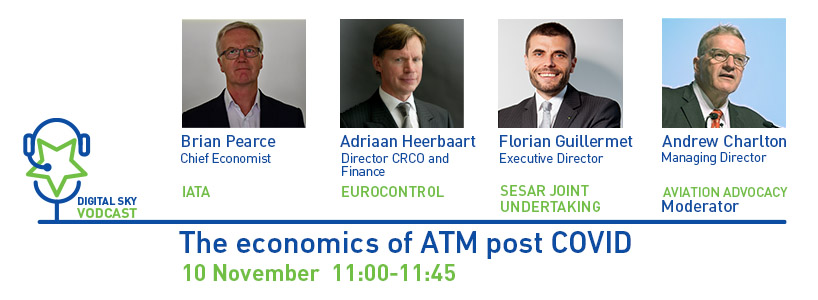T
The COVID pandemic is having an unparalleled economic impact on air traffic management (ATM), calling into question the viability of the business model and the long-term sustainability of the industry. On 10 November, Brian Pearce, Chief Economist, IATA, and Adriaan Heerbaart, Director Central Route Charges Office (CRCO) and Finance, joined Florian Guillermet the Executive Director of the SESAR JU, to explore how making ATM more resilient and scalable could open up opportunities for more sustainable and flexible service provision.
Even with the recent announcement of the possible roll-out of a vaccine against COVID in early 2021, the industry remains highly vulnerable over the next six to twelve months as operations gradually resume. Airlines are cancelling orders while pensioning out older aircraft, all leading to smaller fleets. It is likely that the airline industry in the long run will become more consolidated as a result of the crisis. This comes at a time when air traffic service provision in Europe remains fragmented and faces difficulties to scale service delivery and costs to changing traffic demand. Given the reduced liquidity of the airlines, airports and ANSPs, there is a need now to look at future investments and at how air traffic service provision can become more efficient and economically sustainable.
Some key takeaways from the discussion:
Technology is not disconnected from the business model and the way investments are going to be made in the future. The SESAR research and innovation programme has shown that technology can bring value in terms of modernising the system and managing the airspace more efficiently. One illustration of that is the proposal for a new airspace architecture, which introduced amongst other proposals the notion of data service providers, offering a way to consolidate the data service layer across today’s fragmented infrastructure.
The provisions made in the proposed SES2+ package can offer a more efficient approach to service delivery, starting with the data services layer. Other services could evolve in a similar way, such as those relating to communications, navigation and surveillance.
Changes to the regulatory framework could also be explored in order to be less prescriptive about technology choices and more focused on the performance requirements and the value of that we want to achieve for travelling citizens and businesses making use of air transport.
Linked to this, the performance and incentive schemes should reward pioneers and first movers in making their service delivery more efficient and sustainable.

